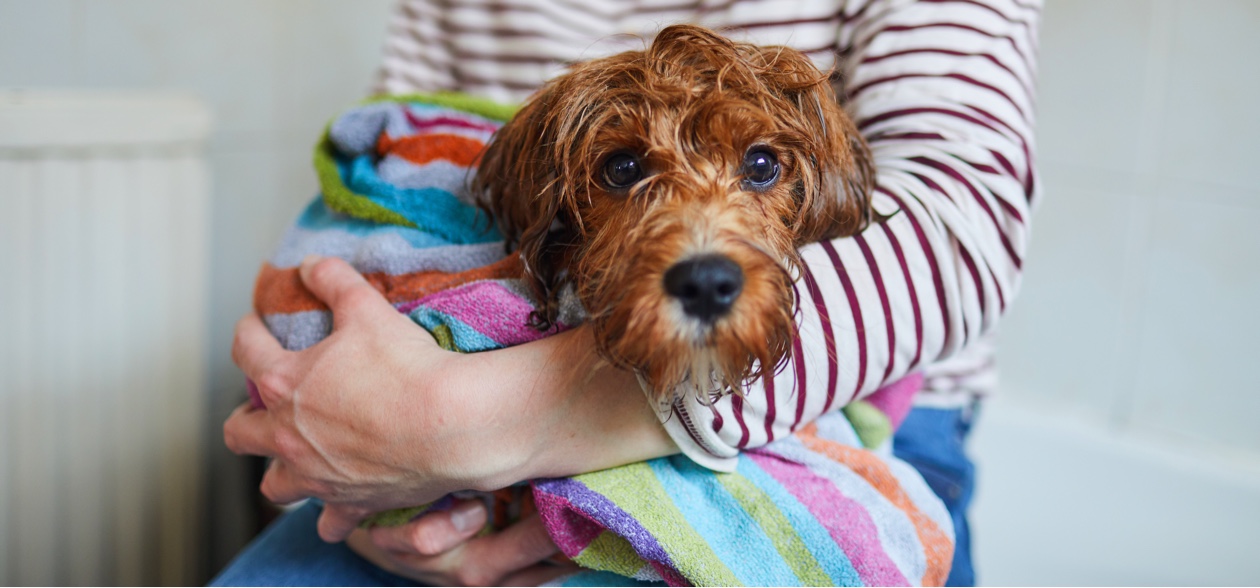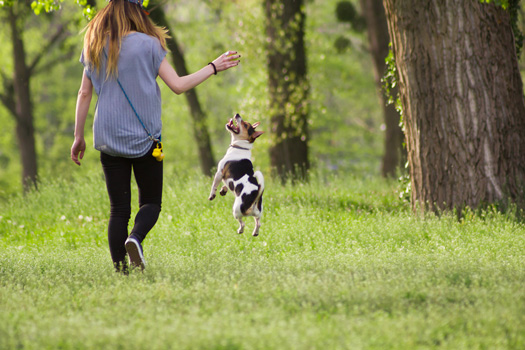
10 common dog behaviours to look out for
Whether they’re a playful pooch, really chilled out or a bit of a troublemaker, every dog has its own distinct personality. Check out our quick fire guide to find out what your dog’s behaviour is telling you and get to know your pet even better.
Published:21 January 2025
Getting to grips with barking, chewing and more
No two dogs are the same and it can sometimes be tricky to know what they need from us or how they feel.
Our guide to the ten most common dog behaviours can give you an insight into why your pooch behaves the way it does. There are also some helpful hints to help you encourage good behaviour and break those bad habits.
1. Digging holes
Has your dog got a habit of digging up the lawn or local play park? Don’t be mad – dogs love to dig and it’s a good way for them to let off steam. You can help them channel their energy elsewhere by fencing off a patch of garden or setting up a sandbox and tempting them to dig there with treats and toys.
2. Jumping up
This is just your dog trying to get your attention but it’s not always socially acceptable and can even be scary for some people. The best way to curb this behaviour is to ignore it – and lavish attention on your dog when it stays down.
3. Chewing
Getting home and finding that your dog has spent the day chewing holes in your shoes is no fun, but your pet isn’t being naughty on purpose. In fact, chewing is a natural dog behaviour. There are ways to curb their habit, though.
First off, move everything tempting out of reach – especially when you’re out of the house. Next, get your dog a few chew toys and anytime you see them chowing down on something they shouldn’t, offer them a toy instead.
4. Constant barking
A bit of barking is perfectly normal but excessive barking could mean your dog is overexcited, bored, anxious or in need of attention. Whatever the reason, here are some steps you can take if the barking gets out of hand:
- Bored dogs need more stimulation, so if your dog seems fed up, you could try walking them more often or pick up a couple of new toys.
- If you dog is overexcited or anxious, speak calmly to them and give clear commands to settle them down.
- Dog barking at the postie? Next time someone comes to your door, try distracting your dog with a command (avoid shouting) and then when they’re quiet, offer them a treat.
If your dog can’t or won’t stop barking, even when you’ve worked at the problem, it could be time to pay your vet a visit.
Another little help: Wondering if there’s a way to spread the cost of vet visits? Read more about the kind of treatments pet insurance can cover.
5. Whining and tail tucking
If your dog is whining and there’s no obvious reason (like a plate of bacon on the table), then they may be feeling uncomfortable or scared. The best way to deal with this is to speak calmly, offer comfort and make sure there’s a safe place for them to hide – whether it’s behind the sofa or under the bed.

6. Begging for table scraps
How can you resist those big puppy eyes? It’s tough, but sadly necessary. If you give your dog scraps off your plate, they will expect a treat every meal time – and beg at the table until they get it. Distract them with toys at dinnertime so they are kept busy while you eat.
7. Peeing in the house
Toilet training your puppy or dog is the first port of call for most owners but what can you do if your previously well trained dog starts peeing indoors? First things first, visit the vet to rule out any medical problems like a urinary tract infection.
Other causes could be anxiety or submissiveness. Build your pup’s confidence by teaching them simple commands and being generous with treats and attention. Remember not to shout though as this could make your dog more nervous.
Another little help: Sometimes puppies pee when they’re excited but usually they’ll grow out of it. That said, rewarding them with treats when they pee outside can help speed up the process.
8. Listless or overexcited dogs
On the whole, dogs are sociable animals – most love to make new friends and have fun. However, others can find it all a bit overwhelming. Training classes or dog walking groups can be a great way to help your dog get used to being around others.
The amount of energy your dog has is directly linked to what breed they are – for example, bulldogs are very chilled out while border collies are full of beans.
For a better idea of how different dogs behave and socialise, check out our dog breeds guides.
9. Biting
Your puppy might think that biting or nipping is a bit of a game. If they do, stop playing and ignore them for a few minutes. Older dogs might bite to protect their toys or food. Socialising with other dogs can help reduce this and teach them how to share.
Another little help: If your dog has started nipping or behaving aggressively, be sure to have a vet check them out. Sometimes this behaviour is linked to pain or discomfort.
10. Separation anxiety
Your dog might get a little sad when you head out for work for the day, but some can develop separation anxiety and act out while they’re alone.
To stop your dog howling, barking and chewing, avoid extended goodbyes and overly enthusiastic returns. Give them treats or distract them with their toys just before you go. Perhaps consider leaving a radio or TV on low volume while you’re out as your dog might find this comforting.
For severe anxiety, it’s a good idea to talk to a vet or a professional trainer. Find out more about separation anxiety and how it affects pets - and pet owners - by checking out our Pet Effect Survey.
Looking for more information?
Tesco Pet Insurance includes vetfone
Get advice for your pet, whenever you need it. Just call the vetfone helpline.
- Talk to vets and nurses registered with the Royal College of Veterinary SurgeonsTalk to vets and nurses registered with the Royal College of Veterinary Surgeons
- 24/7 phone, live chat and video calls24/7 phone, live chat and video calls
- Unlimited access, at no extra costUnlimited access, at no extra cost
Important information
Tesco Pet Insurance is arranged, administered and underwritten by Pinnacle Insurance plc. Tesco Personal Finance Ltd acts as an introducer to Pinnacle Insurance plc which is authorised by the Prudential Regulation Authority and regulated by the Financial Conduct Authority and the Prudential Regulation Authority (register number 110866). Registered Office: Pinnacle House, A1 Barnet Way, Borehamwood, Hertfordshire, WD6 2XX. Tesco Personal Finance Ltd and Pinnacle Insurance plc are not part of the same corporate group.
Vetfone is provided by Vetsdirect Ltd.
Tesco Insurance is a trading name of Tesco Personal Finance Ltd, Registered Office: 2 South Gyle Crescent, Edinburgh, EH12 9FQ (registered in Scotland, no SC173199) which is authorised and regulated by the Financial Conduct Authority (register no. 186022).
We do not provide personal recommendations to customers.
The content on this page aims to offer an informative introduction to the subject matter but does not constitute expert advice specific to your own situation. All facts were correct at time of publication and were compiled using a range of sources.